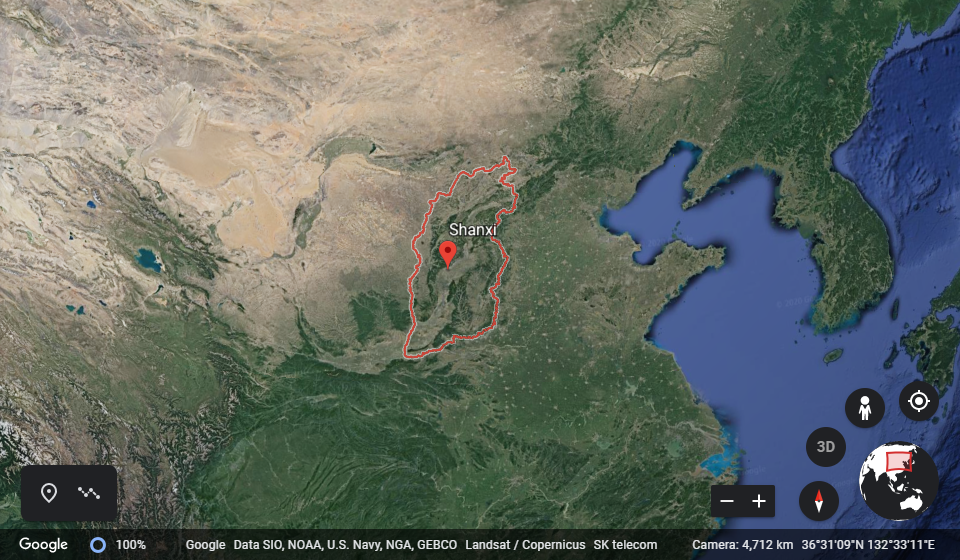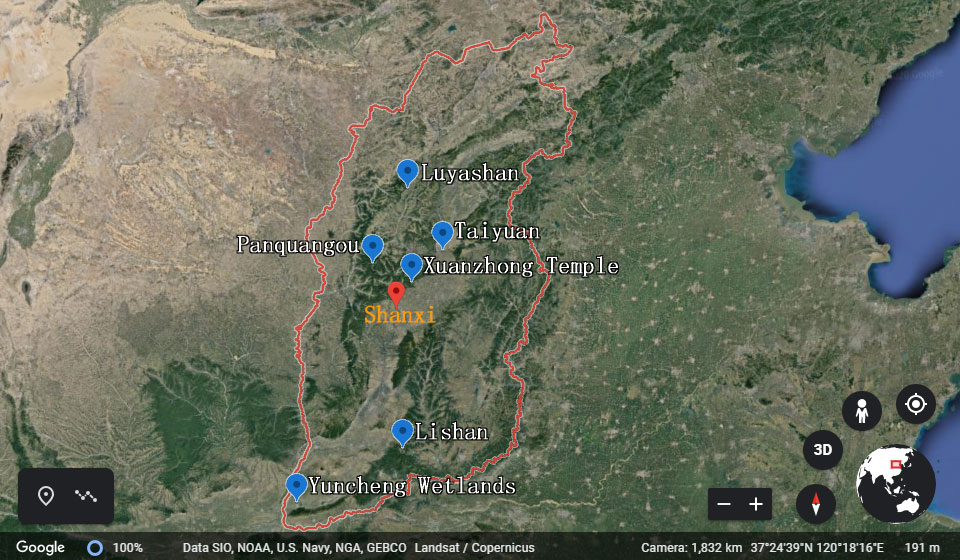Birding info of Shanxi, China

Lying on the Loess Plateau and the middle reaches of the Yellow River, Shanxi Province covers 15.63 square kilometers with 35.71 million inhabitants. The province experiences a temperate continental monsoon climate with dry cold winter and hot humid summer.
Two third of Shanxi's territory is mountains and hills with the elevation between 1,000 meters to 2,000 meters, the rest part consists of plateaus, basins, and terraces. Taihang mountains lie on the east edge of Shanxi province, while Lvliang mountains on the west. The Yellow River flows along the border of the province.
Shanxi has abundant botanical resources with about 1,700 seed plant species, which vegetation type goes from suitable for warm and humid in southeast of Shanxi to drought and hardy tolerant in the northwest. There are 454 vertebrate species have been found in Shanxi including 335 bird species which belong to 55 families under 17 orders. Among them, 225 species are Palaearctic ones, 34 species are Oriental ones and 74 species are widespread ones. The Brown-eared Pheasant which is endemic to China was chosen to be the province bird in 1984. The capital of Shanxi Province is Taiyuan, which has a history of 2,500 years.
Some Important Birding Sites in Shanxi Province

Luyashan Nature Reserve
Established in 1980 and became national reserve in 1997, Luyashan nature reserve located in Ningwu County and covers an area of 21,453 hectares. It was established to protect Brown-eared Pheasant and the forest ecosystem. With large areas of deciduous and spruce forest, the reserve is one of the few areas in Loess Plateau that still keeps undamaged ecosystems. The reserve has recorded 116 bird species, including Black Stork, Golden Eagle, Lammergeier, Coal Tit, Chinese Nuthatch, Chinese Leaf Warbler, etc.
Lishan Nature Reserve
Located in west Shanxi and covering 24,800 hectares, Lishan Nature Reserve was established in 1983 and became national-level reserve in 1988. Belonging to temperate continental monsoon climate, the reserve has the largest primeval forest in North China which covers 800 hectares. The flora and fauna in the reserve situated on the transition region between south and north which contributes the reserve abundant living resources. According to investigates, there are 286 bird species have been recorded which belong to 50 families under 17 orders. Such as Amur Falcon, Brown Shrike, Eurasian Jay, Red-billed Blue Magpie, Yellow-bellied Tit, Silver-throated Bushtit, Manchurian Bush Warbler, Brownish-flanked Bush Warbler, Yellowish-bellied Bush Warbler, Sooty Bushtit, Yellow-browed Warbler, Streak-breasted Scimitar Babbler, Plain Laughingthrush, Vinous-throated Parrotbill, White-crowned Forktail, Taiga Flycatcher, Grey-headed Bullfinch, etc.
Panquangou Nature Reserve
Established in 1980 and upgraded to national nature reserve in 1986, the reserve is located in Fangshan and Jiaocheng Counties. Covering an area of 10,466 hectares, the reserve is one of the eight bird sanctuaries in China and aims to protect the Brown-eared Pheasant. 189 bird species have been recorded in the reserve. The population of Brown-eared Pheasant has increased from 558 since the founding days to 2,000 recently. Other birds like Mandarin Duck, Grey-capped Pygmy Woodpecker, Great Spotted Woodpecker, Black Woodpecker, Red-billed Blue Magpie, Spotted Nutcracker, Coal Tit, Marsh Tit, Willow Tit, Silver-throated Bushtit, Plain Laughingthrush, Chinese Hill Babbler, Chinese Nuthatch, Black-throated Thrush, Red-throated Thrush, Naumann's Thrush, White-winged Redstart, Godlewski's Bunting, Yellow-throated Bunting, etc.
Yuncheng Wetlands Reserve
Established in 2001 and covering 79,830 hectares, the reserve is situated in Yuncheng City along the Yellow River. As one of the most important wetlands in the middle reaches of Yellow River and the largest wetland in Shanxi Province, the reserve is the main wintering habitat for migratory birds in north of China. According to statistics, the reserve has recorded 238 bird species including Black stork, Great Bustard, Whooper Swan, Ruddy Shelduck, Eastern Cattle Egret, Eurasian Sparrowhawk, Hen Harrier, Pied Harrier, Grey-headed Lapwing, Hill Pigeon, Brown Shrike, Chinese Grey Shrike, Black-naped Oriole, Red-billed Blue Magpie, Asian Short-toed Lark, Vinous-throated Parrotbill, Chinese Hill Babbler, Pallas's Bunting, etc.
Xuanzhong Temple
Xuanzhong Temple is situated on Shibi Mountain in the northwest of Jiaocheng County. It is one of birthplaces of Jingtu (Pure Land) Sect, one of important sects of Chinese Buddhism, and is also deemed the birthplace by Pure Land Sect and True Pure Land Sect in Japan. In 1983, it was designated as one of national key temples in the areas of the Han nationality. Xuanzhong Temple was built in the second year (472) of the Yanxing reign of the Northern Wei Dynasty (386-534). It was destroyed by fire, and rebuilt several times during the Ming and Qing dynasties. Because it is the most important place to see the endemic Brown Eared-Pheasant, the Xuanzhong Temple has become one of Shanxi's most famous birding hotspots. Other birds like Eurasian Sparrowhawk, Grey-headed Woodpecker, Great Spotted Woodpecker, Azure-winged Magpie, Spotted Nutcracker, Marsh Tit, Willow Tit, Silver-throated Tit, Beijing Babbler, Vinous-throated Parrotbill, Pere David's Laughingthrush, Long-tailed Rosefinch, Godlewski's Bunting, etc.
Last one: Birding info of Shanghai, China
Next one: Birding info of Taiwan, China







